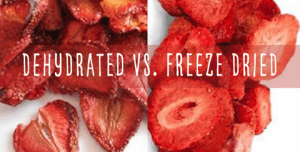Ջրազրկված VS. առողջ նախուտեստ բոլորը կվայելեն

Շատերը կարծում են, որ սառեցված արտադրանքը և ջրազրկված արտադրանքը նույնն են. Թեև դրանք երկուսն էլ լավ են երկարաժամկետ պահեստավորման և շտապ օգնության հավաքածուների համար, their “life sustaining shelf life” is different, ինչպես և դրանց պահպանման գործընթացը.
- Խոնավություն: Սառեցման միջոցով հեռացվում է մոտ 98 սննդի խոնավության տոկոսը, մինչդեռ ջրազրկումը վերացնում է մոտ 90 տոկոսը.
- Պահպանման ժամկետը: Խոնավության պարունակությունը ազդում է պահպանման ժամկետի վրա, միջեւ տեւողությամբ սառեցված չորացրած մթերքների հետ 25 և 30 տարեկան, և ջրազրկված արտադրանքները տևում են մոտ 15 դեպի 20 տարեկան.

- Սնուցում: Սառեցրած սննդամթերքը պահպանում է թարմ մթերքի բնօրինակ վիտամինների և հանքանյութերի մեծ մասը, մինչդեռ ջրազրկման գործընթացը հեշտությամբ կարող է քայքայել այդ սնուցիչները.
Dehydrated vs. Freeze-Dried Food: Understanding the Differences and Making the Right Choice
When it comes to preserving food for long-term storage or outdoor adventures, two popular methods stand out: dehydration and freeze-drying. Both techniques are effective in removing moisture from food, extending its shelf life, and retaining nutrients. Այնուամենայնիվ, they differ in the process, characteristics, and end results. Let’s explore the dissimilarities between dehydrated and freeze-dried food to help you make an informed choice based on your needs.
Moisture Content:
Dehydrated food is created by removing the moisture through low heat over an extended period, typically using an oven or a dehydrator. The process reduces the moisture content to around 10% or lower. On the other hand, freeze-dried food undergoes a unique process where the food is frozen, and then the water is removed through sublimation, a process of changing the solid ice into vapor without turning into liquid water. This results in an even lower moisture content, usually less than 2%, ensuring the food remains lightweight and resistant to spoiling.
Retention of Nutrients and Flavor:
While both methods aim to preserve nutrients and flavor, freeze-drying tends to be more effective in retaining the original taste, գույն, and nutritional value of the food. The rapid freezing and low-temperature dehydration process prevent the formation of ice crystals, which can cause cellular damage to the food. As a result, freeze-dried foods maintain a more natural appearance and flavor compared to dehydrated foods.
Texture and Rehydration:
Dehydrated food often ends up with a chewy or leathery texture due to the slow drying process. Այնուամենայնիվ, it can be crunchy or crispy, depending on the food item and dehydration time. Conversely, freeze-dried food retains its original texture, as the freezing process helps to maintain the food’s cellular structure. When rehydrated, freeze-dried food regains its original shape, գույն, and taste, providing a more enjoyable eating experience.
Shelf Life and Storage:
Both dehydrated and freeze-dried foods have extended shelf lives compared to fresh foods. Այնուամենայնիվ, due to the lower moisture content, freeze-dried food typically boasts a longer shelf life, often ranging from 25 դեպի 30 years when stored properly. Dehydrated food generally has a shelf life of 15 դեպի 20 տարեկան, depending on the storage conditions and the specific type of food.
Weight and Portability:
Freeze-dried food is considerably lighter than its dehydrated counterpart due to the significant reduction in moisture. This makes freeze-dried products an excellent option for backpackers, campers, and emergency preparedness kits, where minimizing weight and maximizing nutrition are essential factors.
Cost:
In general, freeze-dried food tends to be more expensive than dehydrated food. The freeze-drying process is more complex and requires specialized equipment, which can contribute to the higher cost. Dehydrated food, on the other hand, is relatively simple to produce with standard dehydrators or household ovens.
In conclusion, both dehydrated and freeze-dried foods offer excellent options for long-term storage and on-the-go nutrition. Consider your specific needs, budget, and taste preferences when choosing between the two. Dehydrated food might be more suitable for simple and budget-friendly solutions, while freeze-dried food shines in retaining original flavors and textures for a more gourmet experience. Regardless of your choice, both methods provide a fantastic way to enjoy delicious and nutritious meals anytime, anywhere.


